INSTITUT SUPERIEUR D'ANTHROPOLOGIE
INSTITUTE OF ANTHROPOLOGY
ONLINE COURSES / COURS A DISTANCE
WINTER TERM : JANUARY 2016
REGISTER NOW
EGYPTE –  Gizeh -Les scientifiques égyptiens, français, japonais et canadiens qui mènent depuis le 25 octobre le projet ScanPyamids, visant à scanner ces monuments afin de comprendre comment ils ont été construits, ont découvert des "anomalies thermiques" sur quatre pyramides, dont celle de Khéops, a annoncé lundi 9 novembre le ministre égyptien des Antiquités, Mahmoud Eldamaty. Ces premiers résultats des analyses thermiques effectuées depuis le lancement de la mission ouvrent la voie à une multitude d'interprétations. L'une de ces anomalies thermiques "est particulièrement impressionnante", selon un communiqué de presse de la mission. "Elle se situe sur la face est de la pyramide de Khéops, au niveau du sol." Concrètement, quelques blocs de pierre présentent jusqu'à 6 degrés d'écart avec les blocs voisins. Les raisons de l'anomalie thermique demeurent encore inconnues, mais cette dernière pourrait indiquer l'existence d'une chambre secrète.
Gizeh -Les scientifiques égyptiens, français, japonais et canadiens qui mènent depuis le 25 octobre le projet ScanPyamids, visant à scanner ces monuments afin de comprendre comment ils ont été construits, ont découvert des "anomalies thermiques" sur quatre pyramides, dont celle de Khéops, a annoncé lundi 9 novembre le ministre égyptien des Antiquités, Mahmoud Eldamaty. Ces premiers résultats des analyses thermiques effectuées depuis le lancement de la mission ouvrent la voie à une multitude d'interprétations. L'une de ces anomalies thermiques "est particulièrement impressionnante", selon un communiqué de presse de la mission. "Elle se situe sur la face est de la pyramide de Khéops, au niveau du sol." Concrètement, quelques blocs de pierre présentent jusqu'à 6 degrés d'écart avec les blocs voisins. Les raisons de l'anomalie thermique demeurent encore inconnues, mais cette dernière pourrait indiquer l'existence d'une chambre secrète.
http://www.francetvinfo.fr/monde/egypte/egypte-des-anomalies-thermiques-soulevent-un-nouveau-mystere-dans-la-pyramide-de-kheops_1167529.html#xtor=AL-79-%5Barticle%5D-%5Bconnexe%5D
PAKISTAN – 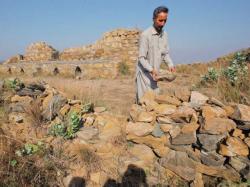 Mardan - Like other historical sites and buildings in the province, the fifth century CE Buddhist monastery and circular stupa, Jamal Garhi, also took a jolt. And so it lost a wall in the 7.5 magnitude earthquake on October 26. Numerous stones from the collapsed wall skidded through the monastery and monk quarters, creating significant damage throughout the structure. According to an employee, Mahmood Khan, “One of the ancient walls completely collapsed from the massive earthquake. We are currently busy collecting the scattered stones and placing them in their proper place.” An ancient Gandharan architecture, it is located 13 kilometres north of Mardan city and rises 122 metres above ground level. The monastery is situated a short distance from Shahbaz Garhi and UNESCO World Heritage site of Takht Bhai, all of which contribute to Mardan being one of the prime tourist attraction spots in Khyber-Pakhtunkhwa. Archaeologists believed Jamal Garhi was established during the era of Gandhara civilisation when Buddhism flourished within the Indian subcontinent. According to Sir John Marshall, a famous British archaeologist, the monastery is one of the earliest sites built in the region. It was first discovered by Sir Alexander Cunningham in 1848 and excavations were carried out from 1852 to 1873. Buddhist and Kharosthi inscriptions were discovered during the work and portions were shifted to Peshawar Museum for display and preservation. Recent excavations in 2012, funded by the government of Japan and UNESCO, discovered coins from 158 CE, sculpture plate, head of Buddha and traces of a lake and other findings. The main stupa is surrounded by chapels. The site also contains a row of quarters used as residence for scholars and monks. Archaeologists suggest Jamal Garhi represents all parts of a Buddhist settlement with chapels and quarters surrounding the monastery.
Mardan - Like other historical sites and buildings in the province, the fifth century CE Buddhist monastery and circular stupa, Jamal Garhi, also took a jolt. And so it lost a wall in the 7.5 magnitude earthquake on October 26. Numerous stones from the collapsed wall skidded through the monastery and monk quarters, creating significant damage throughout the structure. According to an employee, Mahmood Khan, “One of the ancient walls completely collapsed from the massive earthquake. We are currently busy collecting the scattered stones and placing them in their proper place.” An ancient Gandharan architecture, it is located 13 kilometres north of Mardan city and rises 122 metres above ground level. The monastery is situated a short distance from Shahbaz Garhi and UNESCO World Heritage site of Takht Bhai, all of which contribute to Mardan being one of the prime tourist attraction spots in Khyber-Pakhtunkhwa. Archaeologists believed Jamal Garhi was established during the era of Gandhara civilisation when Buddhism flourished within the Indian subcontinent. According to Sir John Marshall, a famous British archaeologist, the monastery is one of the earliest sites built in the region. It was first discovered by Sir Alexander Cunningham in 1848 and excavations were carried out from 1852 to 1873. Buddhist and Kharosthi inscriptions were discovered during the work and portions were shifted to Peshawar Museum for display and preservation. Recent excavations in 2012, funded by the government of Japan and UNESCO, discovered coins from 158 CE, sculpture plate, head of Buddha and traces of a lake and other findings. The main stupa is surrounded by chapels. The site also contains a row of quarters used as residence for scholars and monks. Archaeologists suggest Jamal Garhi represents all parts of a Buddhist settlement with chapels and quarters surrounding the monastery.
http://tribune.com.pk/story/987671/jamal-garhi-tremors-unhinge-mardans-architectural-treasure/
INDE – 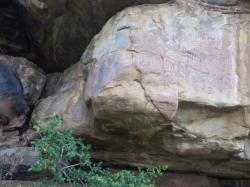 Peddakona - Amateur archaeologists Y. Ramakrishna Reddy and Lakshmi Kanta Reddy, have stumbled upon Mesolithic period rock paintings at Gandikota Fort in Kadapa district. They found the paintings on the rocky surface at Peddakona, also known as Dongalakona, located next to Farah Bagh area on the way from the Anantapadmanabha temple of the fort to the gorge of the river Penna. The paintings representing geometrical designs are seen on a big boulder executed in red ochre. The lines painted in the shape of rectangles, triangles and circles denote abstract forms of some animals. Based on the information given by Mr. Ramakrishna Reddy, archaeologist and CEO of The Cultural Centre of Vijayawada (CCV) E. Sivanagi Reddy inspected the site and confirmed that the rock paintings belong to the Mesolithic period datable to 10,000-8000 B.C. Dr. Reddy said that the paintings executed on a big rock (5.0 mts x 2.00 mts) and vary in size from 1.5 mts to 2.00 mts in length and 0.50 mts to 6.5 mts in height in outline and rendering is done with a single thick brush stroke. Similar paintings of the mesolithic period were earlier noticed in the same district at Chintagunta and Dappalle and Kethavasam in Kurnool district and Bollaram in Mahbubnagar district, according to N. Chandramauli, a specialist in rock art studies of Andhra Pradesh and Telangana.
Peddakona - Amateur archaeologists Y. Ramakrishna Reddy and Lakshmi Kanta Reddy, have stumbled upon Mesolithic period rock paintings at Gandikota Fort in Kadapa district. They found the paintings on the rocky surface at Peddakona, also known as Dongalakona, located next to Farah Bagh area on the way from the Anantapadmanabha temple of the fort to the gorge of the river Penna. The paintings representing geometrical designs are seen on a big boulder executed in red ochre. The lines painted in the shape of rectangles, triangles and circles denote abstract forms of some animals. Based on the information given by Mr. Ramakrishna Reddy, archaeologist and CEO of The Cultural Centre of Vijayawada (CCV) E. Sivanagi Reddy inspected the site and confirmed that the rock paintings belong to the Mesolithic period datable to 10,000-8000 B.C. Dr. Reddy said that the paintings executed on a big rock (5.0 mts x 2.00 mts) and vary in size from 1.5 mts to 2.00 mts in length and 0.50 mts to 6.5 mts in height in outline and rendering is done with a single thick brush stroke. Similar paintings of the mesolithic period were earlier noticed in the same district at Chintagunta and Dappalle and Kethavasam in Kurnool district and Bollaram in Mahbubnagar district, according to N. Chandramauli, a specialist in rock art studies of Andhra Pradesh and Telangana.
http://www.thehindu.com/news/national/andhra-pradesh/amateur-archaeologists-discover-mesolithic-rock-paintings-in-kadapa/article7858656.ece
TURQUIE – 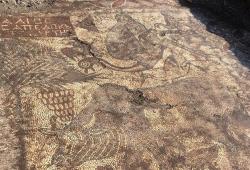 Kayalı - Roman-era floor mosaics unearthed during illegal excavations in the southern province of Osmaniye were rescued from smugglers in a police operation. Adana and Osmaniye security forces, which were informed about an illegal excavation in the village of Kayalı, carried out an extensive operation in five different places and seized the Roman era floor mosaics. Examinations made by the Osmaniye Museum Directorate revealed that the mosaics, which were from the 4th and 5th centuries A.D., were not subject to any damage. The mosaics were covered with earth again and it was reported that rescue excavations and research would start in the area soon.
Kayalı - Roman-era floor mosaics unearthed during illegal excavations in the southern province of Osmaniye were rescued from smugglers in a police operation. Adana and Osmaniye security forces, which were informed about an illegal excavation in the village of Kayalı, carried out an extensive operation in five different places and seized the Roman era floor mosaics. Examinations made by the Osmaniye Museum Directorate revealed that the mosaics, which were from the 4th and 5th centuries A.D., were not subject to any damage. The mosaics were covered with earth again and it was reported that rescue excavations and research would start in the area soon.
http://www.hurriyetdailynews.com/illegal-digs-unearth--mosaics-.aspx?pageID=238&nid=90931
FRANCE – 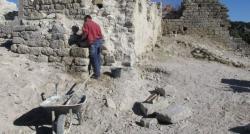 Termes - Dans le cadre de la démarche de longue haleine menée depuis plus de vingt-cinq ans sur les vestiges du château par la mairie de Termes, David Maso et ses employés de l'entreprise Acter étaient présents. Leur mission était de poursuivre le déblaiement archéologique de la partie sommitale, et ensuite consolider les bases du donjon. La campagne de travaux 2015 visait donc dans un premier temps à poursuivre et finir la «purge», le déblaiement de tout ce qui était tombé, quitte à devoir désagréger les pans de mur maçonnés gênant la suite de la démarche. Cela a progressivement été fait, avec le soutien, en juillet, de quelques bénévoles du réseau Rempart, et avec aussi l'usage de brouettes motorisées. Ainsi, une nouvelle et énorme quantité de terre, souches, pierres, a été évacuée. Avec en parallèle le souci de conserver les pierres de taille… et de les stocker. Résultat : le carré intérieur du rez-de-chaussée a été mis au jour, avec au passage l'identification potentielle de trois archères, dans des murs de deux mètres d'épaisseur. Autour, le sol a de nouveau baissé… relevant d'autant la hauteur de ce qu'il reste du donjon. Un donjon carré, assez petit en surface, avec a priori deux étages. Durant ces travaux, une grenade non explosée (mais inoffensive) du XVIIe siècle a été trouvée. C'est un témoignage des opérations de destruction. Elle pèse 2 kg, et a été stockée à l'accueil du château. Les archéologues ont également découvert un four à pain. Une suite est mise en projet pour 2016, avec une consolidation de la chapelle castrale, l'étude du four à pain présumé, quelques petits aménagements et déblaiements complémentaires, toujours en concertation avec l'architecte et l'archéologue.
Termes - Dans le cadre de la démarche de longue haleine menée depuis plus de vingt-cinq ans sur les vestiges du château par la mairie de Termes, David Maso et ses employés de l'entreprise Acter étaient présents. Leur mission était de poursuivre le déblaiement archéologique de la partie sommitale, et ensuite consolider les bases du donjon. La campagne de travaux 2015 visait donc dans un premier temps à poursuivre et finir la «purge», le déblaiement de tout ce qui était tombé, quitte à devoir désagréger les pans de mur maçonnés gênant la suite de la démarche. Cela a progressivement été fait, avec le soutien, en juillet, de quelques bénévoles du réseau Rempart, et avec aussi l'usage de brouettes motorisées. Ainsi, une nouvelle et énorme quantité de terre, souches, pierres, a été évacuée. Avec en parallèle le souci de conserver les pierres de taille… et de les stocker. Résultat : le carré intérieur du rez-de-chaussée a été mis au jour, avec au passage l'identification potentielle de trois archères, dans des murs de deux mètres d'épaisseur. Autour, le sol a de nouveau baissé… relevant d'autant la hauteur de ce qu'il reste du donjon. Un donjon carré, assez petit en surface, avec a priori deux étages. Durant ces travaux, une grenade non explosée (mais inoffensive) du XVIIe siècle a été trouvée. C'est un témoignage des opérations de destruction. Elle pèse 2 kg, et a été stockée à l'accueil du château. Les archéologues ont également découvert un four à pain. Une suite est mise en projet pour 2016, avec une consolidation de la chapelle castrale, l'étude du four à pain présumé, quelques petits aménagements et déblaiements complémentaires, toujours en concertation avec l'architecte et l'archéologue.
http://www.ladepeche.fr/article/2015/11/09/2213637-travaux-de-restauration-au-chateau-de-termes.html
ITALIE – 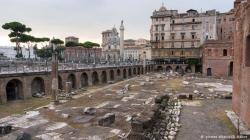
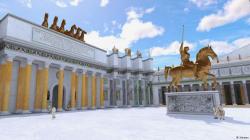 Rome - The Roman Forum, cradle of the biggest empire of the ancient world, has been recreated in stunning 3-D detail by an app that not only shows the site in its original glory, but also chronicles its collapse through time. Remnants of columns, stones and arches - whoever visits the Roman Forum these days needs to have a lot of imagination to conjure an idea of how this place looked in the past. But now for just under 5 euro you can download the Imperial Fora App in English or Italian on your tablet or smart phone to help travel back in time. As you tour the site this app enables you to see what it looked like in the past, so you can compare it with what is still visible today. The app in 3-D shows you the site at the height of the empire in 125 AD, as well as how it looked in the early Renaissance in 1450 - then its decline at the end of the baroque period in 1750. It also shows the site in 1815, when the forum began to be excavated on Napoleon's orders.n"The Imperial Fora app allows everybody to appreciate how Rome evolved from ancient times to today," says Sergio Fontana, an archaeologist who lead a team of academics, graphic designers and IT experts that worked on the project for five years. Professor Daniele Manacorda of Roma Tre University commended it as a "very well researched, but also very accessible" product that should help do away with old-school, "snooty-nosed" approaches to archaeology. He said it was an imperative to popularize ancient history in order to mobilize public support for conservation.
Rome - The Roman Forum, cradle of the biggest empire of the ancient world, has been recreated in stunning 3-D detail by an app that not only shows the site in its original glory, but also chronicles its collapse through time. Remnants of columns, stones and arches - whoever visits the Roman Forum these days needs to have a lot of imagination to conjure an idea of how this place looked in the past. But now for just under 5 euro you can download the Imperial Fora App in English or Italian on your tablet or smart phone to help travel back in time. As you tour the site this app enables you to see what it looked like in the past, so you can compare it with what is still visible today. The app in 3-D shows you the site at the height of the empire in 125 AD, as well as how it looked in the early Renaissance in 1450 - then its decline at the end of the baroque period in 1750. It also shows the site in 1815, when the forum began to be excavated on Napoleon's orders.n"The Imperial Fora app allows everybody to appreciate how Rome evolved from ancient times to today," says Sergio Fontana, an archaeologist who lead a team of academics, graphic designers and IT experts that worked on the project for five years. Professor Daniele Manacorda of Roma Tre University commended it as a "very well researched, but also very accessible" product that should help do away with old-school, "snooty-nosed" approaches to archaeology. He said it was an imperative to popularize ancient history in order to mobilize public support for conservation.
http://www.dw.com/en/new-3-d-app-shows-what-rome-looked-like-over-the-centuries/a-18837301?
EGYPTE – 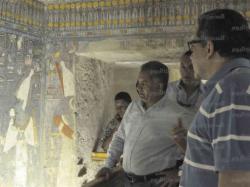 Edfou - Antiquities Minister Mamdouh el-Damati announced the discovery, on Monday, of parts of an archaeological compartment that dates back to the Ptolemaic period and carries images of landscapes that represent King Ptolemy VIII. The discovery was made when a group of people were arrested while digging under a house near Edfu Temple, according to Damati. A committee of archaeologists was formed to inspect the site. It discovered part of the compartment five meters under the ground. The compartment, which has yet to be dug out of the ground, is expected to reach 12 meters high, said Damati. The part that has been discovered bears some images showing Ptolemy VIII presenting the justice symbol "Maat" to the god Horus. Behind him stands the goddess Hathor. The compartment extends under several houses, said Nasr Salama, director general of Aswan antiquities. He added that experts are studying ways in which to dig the monument out of the ground.
Edfou - Antiquities Minister Mamdouh el-Damati announced the discovery, on Monday, of parts of an archaeological compartment that dates back to the Ptolemaic period and carries images of landscapes that represent King Ptolemy VIII. The discovery was made when a group of people were arrested while digging under a house near Edfu Temple, according to Damati. A committee of archaeologists was formed to inspect the site. It discovered part of the compartment five meters under the ground. The compartment, which has yet to be dug out of the ground, is expected to reach 12 meters high, said Damati. The part that has been discovered bears some images showing Ptolemy VIII presenting the justice symbol "Maat" to the god Horus. Behind him stands the goddess Hathor. The compartment extends under several houses, said Nasr Salama, director general of Aswan antiquities. He added that experts are studying ways in which to dig the monument out of the ground.
http://www.egyptindependent.com//news/archeological-compartment-discovered-aswan-minister
EGYPTE – 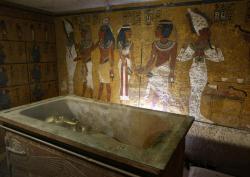 Vallée des Rois - There's new evidence to support a theory that King Tutankhamun's tomb may be hiding two secret chambers. And these hidden rooms could solve an ancient mystery: What happened to Queen Nefertiti? On Thursday and Friday, the walls of Tut's tomb in the Valley of the Kings were scanned using infrared thermography. “The preliminary analysis indicates the presence of an area different in its temperature than the other parts of the northern wall," Mamdouh el-Damaty, the Egyptian minister of antiquities, told National Geographic. While more time is needed to confirm the results, the changes in temperature could be the result of open space behind the wall. That would support a headline-making theory proposed over the summer by archaeologist Nicholas Reeves, who examined high-resolution scans of the walls and found what he believes to be evidence of two plastered-over doorways.
Vallée des Rois - There's new evidence to support a theory that King Tutankhamun's tomb may be hiding two secret chambers. And these hidden rooms could solve an ancient mystery: What happened to Queen Nefertiti? On Thursday and Friday, the walls of Tut's tomb in the Valley of the Kings were scanned using infrared thermography. “The preliminary analysis indicates the presence of an area different in its temperature than the other parts of the northern wall," Mamdouh el-Damaty, the Egyptian minister of antiquities, told National Geographic. While more time is needed to confirm the results, the changes in temperature could be the result of open space behind the wall. That would support a headline-making theory proposed over the summer by archaeologist Nicholas Reeves, who examined high-resolution scans of the walls and found what he believes to be evidence of two plastered-over doorways.
http://www.huffingtonpost.com/entry/king-tut-tomb-infrared-scans_56403c64e4b0b24aee4ac67d